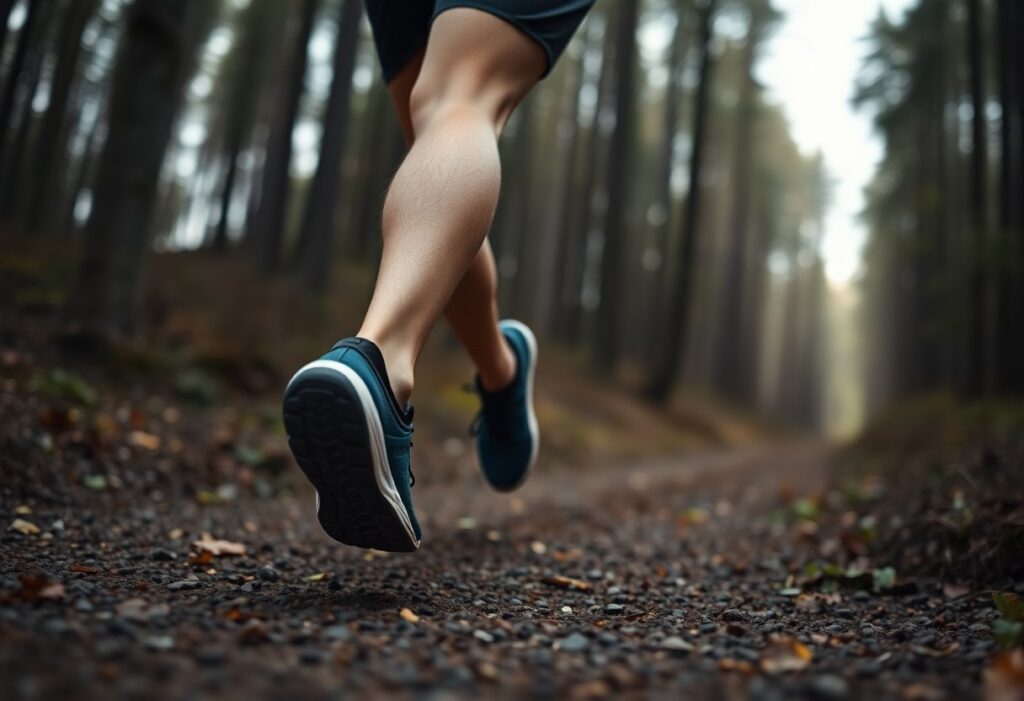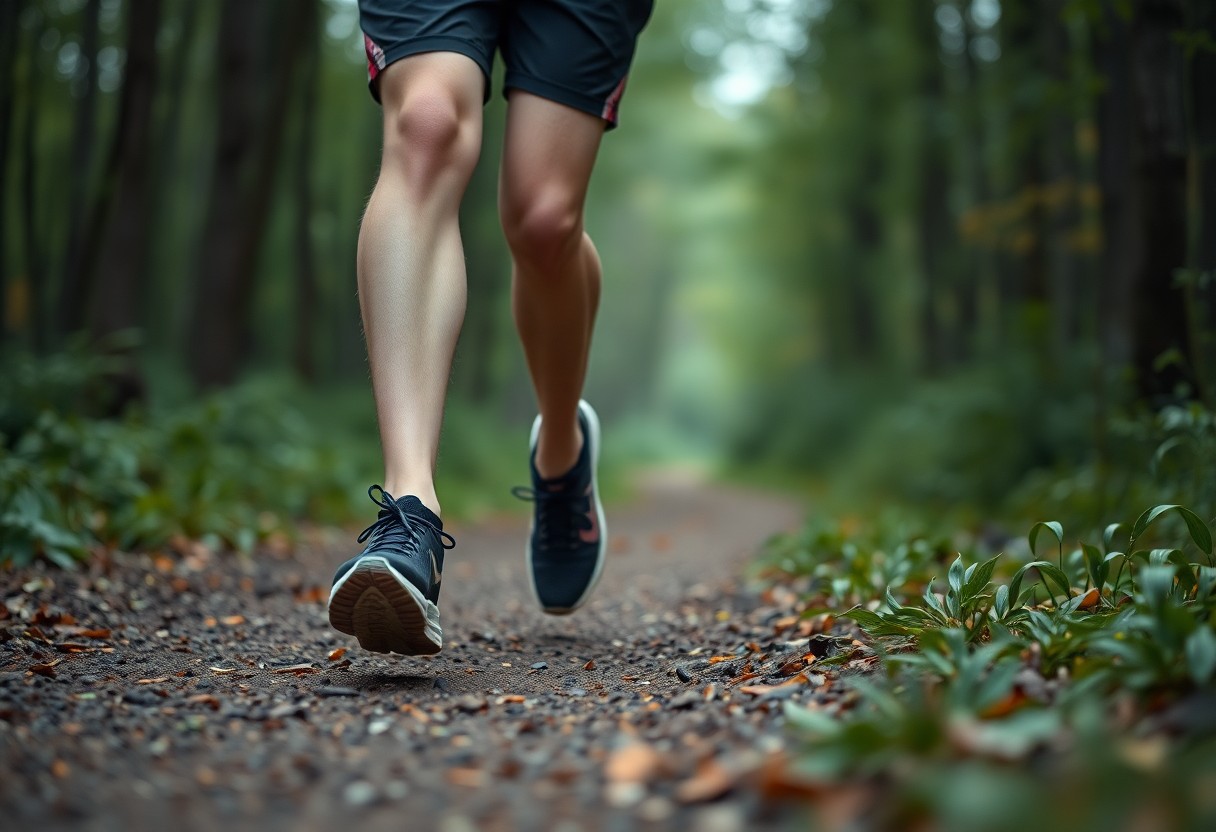
The alarming rate of injuries affecting trail runners can escalate to a staggering 62% each year, often linked to the use of unsuitable footwear. To improve your running performance while reducing injury risks, it is vital to understand the biomechanics of minimalist footwear and its interaction with uneven terrain. Employing wearable technology can help track essential metrics such as foot strike dynamics and load patterns, while personalized training plans are tailored to enhance foot strength and endurance. This article explores how to utilize biomechanical insights and innovative technology for effective injury prevention strategies.

Overcoming the Unique Challenges of Trail Running with Minimalist Footwear
Successfully navigating the varied and rugged landscapes of trail running with minimalist footwear requires more than simply choosing the right shoes; it demands a comprehensive understanding of your own biomechanics. Ignoring the specific challenges presented by different surfaces can greatly increase your likelihood of injuries. As the mechanics of foot strike patterns and descent vary across terrains, adapting your running technique is essential for sustaining peak performance and minimizing injury risks.
Decoding Biomechanical Foot Strike Patterns on Challenging Trails
When traversing complex landscapes, foot strike dynamics can differ significantly. Runners who opt for minimalist footwear often show a substantial 23% increase in midfoot strikes on uneven trails, in sharp contrast to the 8% recorded with traditional running shoes. This adaptation may enhance your stability on difficult surfaces; however, it also results in a 37% rise in metatarsophalangeal joint flexion angles. This emphasizes the crucial need to strengthen your foot muscles to improve endurance and minimize the risk of injury while trail running.
Analyzing the Influence of Descent Mechanics and Ground Interaction on Performance
The mechanics involved in descending from heights are crucial to your performance and injury risk in trail running. Utilizing minimalist footwear can lead to a significant 42.191 BW/s increase in vertical loading rates on steep 15% declines, particularly when compared to flat roads. This increase in loading results in greater lateral toe engagement, which is noted to be 11% higher on loose gravel than on stable surfaces. This highlights the increased demands placed on the structural integrity of your feet during downhill runs.
As you tackle technical trails in minimalist shoes, the biomechanics of your feet respond distinctly. The increased vertical loading rates while descending can cause more fatigue in your foot muscles, making you more prone to injuries. Moreover, significant shifts in toe splay patterns necessitate improved proprioception and muscle coordination, allowing you to respond effectively to the varying terrain beneath your feet. By focusing on these elements, you can prepare your body to tackle the challenges posed by different trails and enhance your overall running performance.
Recognizing the Limitations of Wearable Technology in Trail Running
Although wearable technology has revolutionized trail running, it comes with significant challenges when it comes to accurately tracking performance metrics. The variability of terrain conditions, including steep declines and uneven surfaces, complicates the process of gathering and interpreting data. For example, wearable devices often find it difficult to provide consistent vertical oscillation measurements due to changing ground conditions, leading to potentially misleading interpretations of your gait and running efficiency.
Investigating Accuracy Discrepancies Among Leading Performance Tracking Devices
Considerable discrepancies in data accuracy have been observed among top performance tracking devices. A study from 2024 uncovered a 12.4% difference in power measurements on 10% inclines between the Stryd and GARMINRP devices, even though both showcased high intra-device reliability (ICC=0.89). These inconsistencies can lead to misguided beliefs about your training load and overall performance, potentially hindering your ability to refine your trail running skills effectively.
and GARMINRP devices, even though both showcased high intra-device reliability (ICC=0.89). These inconsistencies can lead to misguided beliefs about your training load and overall performance, potentially hindering your ability to refine your trail running skills effectively.
The Risks Associated with Miscalculating Training Loads
Miscalculating training loads can increase by as much as 23% on mixed-terrain routes, directly affecting your injury risk and performance progression. This often results from inaccurate data interpretations during technical descents or uneven terrains, forcing you to rely on potentially flawed metrics. Such discrepancies may lead to overtraining or inadequate load management, significantly raising the likelihood of sustaining injuries while running.
While navigating complex trail surfaces, the gap between perceived exertion and actual effort can distort your training insights. If your device underreports your exertion, you may unknowingly exceed your limits, resulting in increased fatigue and slower recovery. Conversely, if your training load is overestimated, you might adopt a more cautious approach, inadvertently limiting your performance improvement. In conclusion, ensuring that your wearable technology supports rather than misguides your training strategy is crucial for maintaining both performance and overall health in the vibrant world of trail running.
Examining Gender Dynamics in Trail Running Biomechanics
Developing a thorough understanding of the biomechanical differences between male and female trail runners can greatly enhance performance while reducing injury risks. Research suggests that anatomical and physiological discrepancies impact shoe selection, gait patterns, and vulnerability to injuries. Customizing footwear and training regimens based on these gender dynamics fosters safer and more effective outdoor running experiences.
Analyzing Gender-Specific Biomechanical Responses Post-Exercise
After exercise, female runners exhibit a 19% increase in lateral forefoot pressures compared to male runners following 5km barefoot runs. Furthermore, they demonstrate a 22% decrease in navicular drop during 50km ultra-marathons, indicating that their biomechanical responses to trail running are distinct. Recognizing these patterns is vital for improving footwear design that caters to the unique biomechanics of female runners.
Implementing Challenges with Gender-Specific Tailored Solutions
To effectively address the unique biomechanics of female runners, it is crucial to apply customized solutions that take their specific physical characteristics into account. Tailoring training programs, utilizing gender-specific footwear, and enhancing strength regimens can significantly lower injury rates while boosting running performance. For example, integrating exercises that focus on intrinsic foot muscle endurance and stability can be particularly beneficial for women, who may encounter different loading patterns on technical terrains.
By examining data from various studies and integrating findings on gender-specific responses, you can better concentrate on training and footwear that actively support your individual biomechanics. For instance, employing targeted strength training programs that bolster the lower leg and foot can help your body adjust to the increased demands of trail running. This is particularly relevant for women, who often experience greater pressure in the forefoot area. Choosing shoes specifically designed for your unique foot mechanics can further aid in addressing common injuries, ultimately promoting a more rewarding and sustainable trail running journey.

Harnessing Innovative Techniques for Real-Time Gait Analysis
Enhancing your running performance and safety can greatly benefit from the implementation of real-time gait analysis through advanced technological solutions. By utilizing integrated systems and wearable devices, you can receive immediate feedback on your foot strike patterns, body mechanics, and overall movement efficiency. These innovative tools are designed to provide actionable insights while you are actively engaged on the trail, allowing you to dynamically adjust your technique and prevent repetitive strain injuries commonly associated with improper running form.
The Critical Role of Embedded Sensors in Injury Prevention
Embedded sensors in footwear play a vital role in preventing injuries. They continuously track your foot strike patterns and pressure distributions in real-time, delivering immediate corrective feedback. This cutting-edge technology allows you to pinpoint deviations from optimal running mechanics before they develop into serious injuries. With only a 19-millisecond latency for ground contact alerts, you will receive timely notifications that help you stay aligned with biomechanical standards essential for injury avoidance.
Longitudinal Research Highlighting the Effectiveness of Biometric Feedback Technologies
Longitudinal studies have shown significant reductions in injury rates among trail runners who utilize biometric feedback technologies. Over a six-month period, athletes experienced a 37% decrease in aberrant loading patterns due to consistent monitoring and adjustments based on real-time data. This compelling evidence underscores how ongoing engagement with these technologies can enhance your running economy and resilience, significantly diminishing the likelihood of injuries associated with gait abnormalities.
For instance, a comprehensive study involving 250 trail runners documented the effectiveness of wearable sensors in identifying patterns that cause overuse injuries. Runners who actively interacted with feedback systems reported a 30% lower occurrence rate of common injuries such as plantar fasciitis and Achilles tendinitis compared to those who relied solely on traditional training methods. The emphasis on continuous tracking, paired with targeted adjustments based on data insights, illustrates a shift towards a more proactive approach to injury prevention in the realm of trail running.
Final Thoughts on Trail Running Biomechanics
Ultimately, grasping the intricacies of biomechanics in trail running while utilizing minimalist footwear is essential for optimizing your performance and minimizing injury risks. By seamlessly integrating wearable technology and adopting personalized training methodologies, you can significantly enhance your foot strength and adaptability to various terrains. Regularly cross-reference metrics from different devices and monitor your gait using advanced tools to effectively tailor your training regimen. This strategic approach not only supports your running journey but also promotes sustainable practices within your outdoor adventures.
The Article Trail Running Biomechanics in Minimalist Footwear: Integrating Wearable Technology and Injury Prevention Strategies appeared first on My Shoes Finder
The Article Trail Running Biomechanics: Injury Prevention with Minimalist Shoes Was Found On https://limitsofstrategy.com







